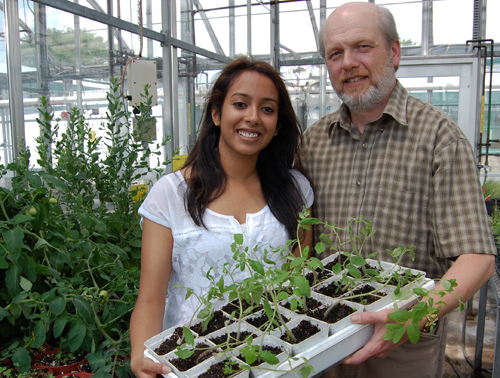Story by Katharine Tuerke, a graduate of the SPARK program (Students Promoting Awareness of Research Knowledge)

Master’s student Rochelle Tazhoor and Prof. Paul Goodwin are testing plant defence activators that could help tomatoes fight disease from the inside out.
Tomatoes are highly susceptible to bacterial diseases, and few options are available to control the problem. Copper bactericides are currently used, but these may fail if the diseases become too severe or if the bacteria can tolerate copper. Soon, however, tomato plants may be able to fend for themselves against bacterial diseases such as speck and spot without the help of conventional pesticides.
Environmental sciences professor Paul Goodwin, plant pathologist Cheryl Trueman and master’s student Rochelle Tazhoor are testing how different plant defence activators improve the management of bacterial diseases.
“Turning up the plant’s immune response before the pathogen attacks can help the plant build a faster, stronger resistance to disease,” says Goodwin. “Our goal is to develop a comprehensive package for producers on how to efficiently use defence activators to control speck and spot under Ontario’s growing conditions.”
Plant defence activators work something like vaccines in animals – they trigger resistance against disease. The activators crank up the plant’s natural immune response by tricking it into perceiving that it’s being attacked. If the plant is later infected by bacteria, it already has some defences ready, which will limit the pathogen’s spread and reduce disease symptoms.
“Boosting the plant’s own resistance will provide all tomato farmers, but especially organic farmers, with a new approach to controlling bacterial speck and spot,” says Goodwin.
In the lab, Goodwin and Tazhoor inoculate tomato plants with bacteria about a week after the plants have been treated – or not treated – with a defence activator. Then they count the number of lesions per leaf to see how much disease has developed. They’re also examining the effect of various application methods and concentrations of defence activators, and they want to know if altering a tomato plant’s defence system will translate into changes in its gene expression.
The researchers are also investigating how well defence activators control speck and spot in the field.
Trueman is in the final year of a three-year study comparing the use of defence activators in tomato plants with the traditional control method of applying copper bactericide. So far, the results show that defence activators may be a promising alternative. No reductions in tomato yield or quality have been observed.
Funding for this project was provided by the OMAF—U of G Partnership. Additional funding was provided by Syngenta Crop Protection Canada and the Ontario Tomato Research Institute.